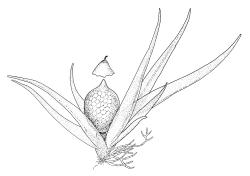Plants minute, with a persistent creeping or subterranean protonema. Stems very short, mostly without central strand. Leaves very small, narrow and elongate, acuminate; laminal cells thin-walled and lax, smooth or less often prorate. Costa weak or lacking.
Mostly dioicous. Male plants minute, bud-like, with or without paraphyses. Setae very short (<0.5 mm) or apparently lacking; capsules spherical or ellipsoid, lacking a neck, indehiscent or splitting irregularly near mid capsule; exothecial cells thin-walled and lax; annulus lacking; stomata superficial, 2-celled; columella usually resorbed at maturity. Peristome nil. Calyptra mitrate or cucullate, either deciduous or persistent. Spores large.
A family of minute and short-lived mosses, traditionally placed (Brotherus 1924) close to the Funariaceae but differentiated from it by having stomata, when present, with two guard cells. Recent molecular studies (Cox et al. 2010) as well as some recent assessments (Goffinet et al. 2009; Holyoak 2010) place some members of the Ephemeraceae, or the entire family, in the Pottiales, near to (or even in) the Pottiaceae.
However, the family is retained as separate here, largely because of its distinctive and unique morphology, and also for convenience and to conform with its treatment in the Flora of Australia by Stone (2006). Stone (1996) provided a useful revision of the Australian members. She appears to have considered all the seven species she treated to be indigenous (and several endemic) members of the Australian flora, although the distribution (Smith 2004) of E. recurvifolium suggests that it, at least, may be adventive in in that country. The contrast between the numerous allegedly indigenous/endemic Australian species and the three species occurring in N.Z., all interpreted here as adventive, is great. It is also surprising that no species occurring in N.Z. is reported from Australia (Stone 2006).
A still useful revision of the North American species, with micrographs illustrating variation of leaf morphology of all those species, was published by Bryan & Anderson (1957).
The members of this family nearly all occur on damp bare soil, in spring, winter, and autumn, when competition from higher plants is minimal. The three N.Z. representatives are known only from the NI; all appear to be adventive species from the northern hemisphere.
| 1 | Protonema sparse; capsules not apiculate, dehiscent by a weakly differentiated row of equatorial cells, c. 0.25 mm diam.; calyptra minute (consisting of the unexpanded archegonium), persistent at the capsule apex | Micromitrium tenerum |
| 1' | Protonema abundant; capsule apiculate and cleistocarpous, ≥0.4 mm diam.; calyptra mitrate, deciduous | 2 (Ephemerum) |
| 2 | Leaves costate, entire or nearly so; perigonial buds present at base of fertile stems; stomata present in upper ½ of capsules; spores coarsely bullate-papillose | Ephemerum sessile |
| 2' | Leaves ecostate, coarsely spinose-toothed; perigonial buds not present at base of fertile stems; stomata restricted to extreme base of capsules; spores finely papillose | Ephemerum serratum |
| Category | Number |
|---|---|
| Exotic: Fully Naturalised | 3 |
| Total | 3 |




